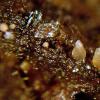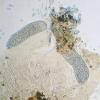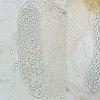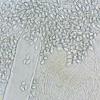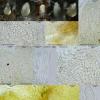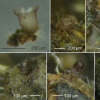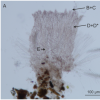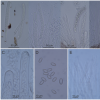
08-11-2025 00:29
 Francois Guay
Francois Guay
I found this species in Quebec, Canada, on herbace

04-11-2025 09:07
Hello.A suspected Hymenoscyphus sprouting on a thi

04-11-2025 12:43
 Edvin Johannesen
Edvin Johannesen
Hi! One more found on old Populus tremula log in O

03-11-2025 21:34
 Edvin Johannesen
Edvin Johannesen
These tiny (0.4-0.5 mm diam.), whitish, short-stip

28-10-2025 15:37
Carl FarmerI'd be grateful for any suggestions for this strik
Unknown multispored ascomycete
Norbert Heine,
23-06-2023 14:56
 Dear friends,
Dear friends,on dung of deer I found a small +/- conical yellow-brownish ascomycete (max. 270 x 170 µm). Mostly there are 2-6 asci per apothecium. The asci are narrow cylindrical (190-230 x 45-55 µm) and multispored, with a very short and hardly visible stipe. There are much more than 300 spores visible, so I think it must be 512 spores per ascus! The dimensions of the spores are (9)10-12 x (4)5 µm.
I've been dealing with coprophilous fungi for over 25 years but I've never seen anything like this before.
Dennisiopsis multispora I can exclude because of it's 128-spored asci and another habitus. Caccobius minusculus is similar but with much smaller ascospores and about 1000-spored asci. Maybe it's an unspecified species of this genus? What do you think?
I am happy about every idea.
Norbert
PS. For the plate I thank my friend Matthias Reul.
Nicolas VAN VOOREN,
23-06-2023 15:21

Re : Unknown multispored ascomycete
Hallo Norbert.
Did you exclude the genus Thelebolus?
Did you exclude the genus Thelebolus?
Norbert Heine,
23-06-2023 16:52

Re : Unknown multispored ascomycete
Thank you for the answer, Nicolas!
I don't believe to the genus Thelebolus. T. dubius var. lagopi and T. polysporus I know very well and I can exclude these species. Also I think that we can exclude all the other descripted species of this genus.
I think that the excipulum is something special.
Norbert
Michel Delpont,
23-06-2023 18:51

Re : Unknown multispored ascomycete
Sorry, I had the same idea as Nicolas, but I wonder if there aren't more than 512 spores per asques. Nice photos.
Michel.
Alexander Karich,
11-07-2023 11:48

Re : Unknown multispored ascomycete
Hi Nobi,
this find reminds me a bit on the apothecia I found on mongolian dung of Ochotona spp.
Unfortunately i did not find a correct name either, and the I failed to sequence the specimens.
Micro description:
Ascospores ellipsoid, hyaline, smooth, 8.5-9.53-10-5 µm x 4.5-5.05-5.5 µm Q= 1.8-1.89-2.0 (medians: l=9.4 b=5.5 Q=1.9). Asci 128-spored, narrow cylindrical, operculate, relatively thick-walled, not amyloid, 180-220 µm long and 16-19 µm wide. Paraphyses long filiform, septate, hyaline, without contents, up to 3 µm thick. Cells of the excipulum pigmented, with purplish tone, a textura angularis-globosa, some cells moniliformly strung together (up to about 13 µm wide) and ending in hair-shaped, cylindrical, multiply septate and incrusted, max. 6 µm wide, terminal cells covering the entire fruiting body.
Attached you find some macro- and micro-plates, however, I believe that you know these already.
Kind regards,
Alex
this find reminds me a bit on the apothecia I found on mongolian dung of Ochotona spp.
Unfortunately i did not find a correct name either, and the I failed to sequence the specimens.
Micro description:
Ascospores ellipsoid, hyaline, smooth, 8.5-9.53-10-5 µm x 4.5-5.05-5.5 µm Q= 1.8-1.89-2.0 (medians: l=9.4 b=5.5 Q=1.9). Asci 128-spored, narrow cylindrical, operculate, relatively thick-walled, not amyloid, 180-220 µm long and 16-19 µm wide. Paraphyses long filiform, septate, hyaline, without contents, up to 3 µm thick. Cells of the excipulum pigmented, with purplish tone, a textura angularis-globosa, some cells moniliformly strung together (up to about 13 µm wide) and ending in hair-shaped, cylindrical, multiply septate and incrusted, max. 6 µm wide, terminal cells covering the entire fruiting body.
Attached you find some macro- and micro-plates, however, I believe that you know these already.
Kind regards,
Alex
Alexander Karich,
11-07-2023 11:52
Norbert Heine,
13-07-2023 18:26

Re : Unknown multispored ascomycete
Thanks for the additions, Alex!
I think both yours and mine finds are undescribted species of the genus Caccobius! Unfortunately no one seems to know them in the whole wide world.
Norbert
I think both yours and mine finds are undescribted species of the genus Caccobius! Unfortunately no one seems to know them in the whole wide world.
Norbert


